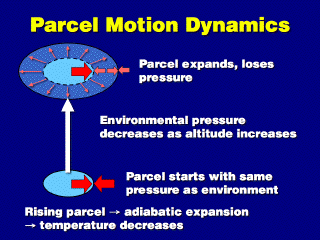 A
rising air parcel adiabatically expands because the atmospheric pressure outside
of the parcel decreases as the parcel gains altitude. With less pressure outside,
the pressure force inside the air parcel pushes the parcel boundary outwards,
expanding the parcel. As the parcel expands, the pressure inside decreases.
The parcel will expand only until the pressure inside becomes equal to the pressure
outside.
A
rising air parcel adiabatically expands because the atmospheric pressure outside
of the parcel decreases as the parcel gains altitude. With less pressure outside,
the pressure force inside the air parcel pushes the parcel boundary outwards,
expanding the parcel. As the parcel expands, the pressure inside decreases.
The parcel will expand only until the pressure inside becomes equal to the pressure
outside.
 Air parcels lose temperature when they
rise while unsaturated due to an adiabatic expansion. When this happens,
the air temperature inside the parcel converges with the dew point temperature
of the air inside the parcel. When the two temperatures coincide, the air inside
the parcel becomes saturated. Further lifting decreases the temperature below
the dew point temperature, producing supersaturation, which leads to condensation
of cloud droplets. The altitude at which saturation occurs inside the parcel
is the lifting condensation level, or LCL. The bases of clouds
will be at the LCL.
Air parcels lose temperature when they
rise while unsaturated due to an adiabatic expansion. When this happens,
the air temperature inside the parcel converges with the dew point temperature
of the air inside the parcel. When the two temperatures coincide, the air inside
the parcel becomes saturated. Further lifting decreases the temperature below
the dew point temperature, producing supersaturation, which leads to condensation
of cloud droplets. The altitude at which saturation occurs inside the parcel
is the lifting condensation level, or LCL. The bases of clouds
will be at the LCL.
To determine the altitude of the
LCL, we need to know the initial parcel temperature and dew point. The greater
the dew point depression,
the higher the air parcel must rise to reach the LCL. This is because the air
parcel needs to lose more temperature to become saturated, when the dew point
depression is large.



 A
rising air parcel adiabatically expands because the atmospheric pressure outside
of the parcel decreases as the parcel gains altitude. With less pressure outside,
the pressure force inside the air parcel pushes the parcel boundary outwards,
expanding the parcel. As the parcel expands, the pressure inside decreases.
The parcel will expand only until the pressure inside becomes equal to the pressure
outside.
A
rising air parcel adiabatically expands because the atmospheric pressure outside
of the parcel decreases as the parcel gains altitude. With less pressure outside,
the pressure force inside the air parcel pushes the parcel boundary outwards,
expanding the parcel. As the parcel expands, the pressure inside decreases.
The parcel will expand only until the pressure inside becomes equal to the pressure
outside. Air parcels
Air parcels